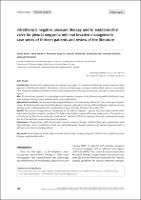Intrathoracic negative pressure therapy and/or endobronchial valve for pleural empyema minimal invasive management: case series of thirteen patients and review of the literature

View/
Date
2020Author
Panko, Siarhei
Vakulich, Denis
Karpitski, Aliaksandr
Zhurbenka, Henadzi
Shestiuk, Andre
Boufalik, Rostislav
r Ihnatsiuk, Aliaksand
Metadata
Show full item recordAbstract
Introduction: Intrathoracic negative pressure therapy is an adjunct to standard methods of complex empyema management
in debilitated patients. Nevertheless, the use of endoscopic one-way endobronchial valves to successfully
close large bronchopleural fistulas in patients with advanced pleural empyema has been described in only a few case
reports.
Aim: To present our experience in managing complex pleural empyema using thoracostomy with intrathoracic negative
pressure therapy and/or endobronchial valve implantation.
Material and methods: We retrospectively analyzed data from 13 consecutive patients (11 men, mean age: 56 years,
range: 38–80 years) who were treated for pleural empyema using thoracostomy with intrathoracic negative pressure
therapy and/or endobronchial valve implantation between October 2015 and November 2017.
Results: The control of empyema was satisfactory in 12 patients; however, 1 patient died from sepsis-related multiorgan
failure despite complete cessation of air leak on day 9 after endobronchial valve implantation. The overall success
rate for the final closure of the chest wall was 9/12 patients (75%): in 5 patients, the wall closed spontaneously,
and in 4, the wall was closed using thoracomyoplasty.
Conclusions: Thoracostomy with intrathoracic negative pressure therapy, endobronchial valve implantation with
tube drainage, and a combination of the two could adequately manage patients with pleural empyema with or
without a persistent air leakage fistula.